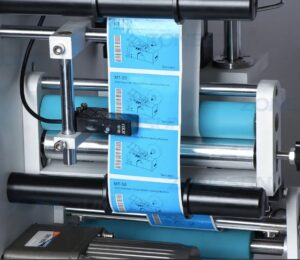目录
ToggleIn modern manufacturing, labeling is a crucial step. As technology advances, more and more companies are turning to Labeling Machines to improve production efficiency and reduce human intervention. Based on different production needs, labeling machines can be divided into Semi-Automatic Labeling Machines and Automatic Labeling Machines.Understanding these differences helps businesses choose the right equipment based on their needs and optimize production line efficiency, especially in the context of automatic filling lines.
What are Semi-Automatic and Automatic Labeling Machines?
- Semi-Automatic Labeling Machines:
Semi-automatic labeling machines require partial manual operation. Operators must place the products in position, after which the machine will automatically apply the label. Once the labeling is complete, workers remove the labeled items. These machines are ideal for low-volume production or situations where labeling precision is not the highest priority. - Automatic Labeling Machines:
These machines operate entirely automatically, with no need for manual handling or supervision. They work effortlessly with other production line systems, including filling and capping machines, ensuring smooth, uninterrupted operation. These machines apply labels without any manual input, making them perfect for high-throughput environments, especially in automatic filling lines.
Key Differences Between Semi-Automatic and Automatic Labeling Machines

Automation Level:
- Semi-Automatic Labeling Machines: These machines rely on manual operation for part of the process, reducing labor but not fully automating the task.
- Automatic Labeling Machines: Operate entirely autonomously, eliminating the need for any manual input during the labeling process. They integrate with other equipment, achieving a high level of automation, especially in automatic filling lines.
Production Efficiency:
- Semi-Automatic Labeling Machines: Because manual intervention is required, production efficiency is lower, making them suitable for small-batch or low-volume production.
- Automatic Labeling Machines: These machines can continuously apply labels, significantly increasing production efficiency. They are ideal for large-scale production, especially in automatic filling lines, where they operate at high speeds, reduce human labor, and enhance overall productivity.
Application Scenarios:
- Semi-Automatic Labeling Machines: Best suited for small-batch production or situations where labeling accuracy is not a high priority.
- Automatic Labeling Machines: Perfect for large-scale production lines, particularly those requiring fast and efficient production in automatic filling lines.
Cost:
- Semi-Automatic Labeling Machines: Semi-automatic labeling machines are more cost-effective, making them a great option for businesses with budget constraints.
- Automatic Labeling Machines: These machines come with a higher initial cost but offer long-term savings through increased efficiency and reduced labor costs. They are ideal for high-volume, long-term production.
Precision and Stability:
- Semi-Automatic Labeling Machines: Precision and stability may be lower due to manual operation, and the labeling process can be affected by human error.
- Automatic Labeling Machines: These machines offer high precision and stability, ensuring consistent quality even in high-speed environments, which is critical in automatic filling lines.
Labeling in Automatic Filling Lines
In modern automatic filling lines, labeling machines play a vital role. These machines work in conjunction with filling machines, capping machines, and other equipment to create a fully automated production process, improving efficiency and the quality of the products.
- Increased Production Efficiency:
Automatic labeling machines integrate seamlessly with other automated equipment, reducing human involvement and errors, and improving overall production efficiency. - Improved Product Quality:
Automatic labeling machines ensure that labels are applied with high accuracy, maintaining consistent positioning and alignment across all products, which improves overall product quality. - Adaptability to Various Labels and Product Types:
Automatic labeling machines are highly adaptable, able to adjust to different product types (cylindrical, flat, square, etc.) and various label sizes, providing flexibility and consistency in labeling. - Waste Reduction:
Automation reduces material waste, particularly during the labeling process. Features like automatic label alignment and misalignment detection help avoid mistakes that lead to waste, optimizing production costs and improving efficiency.
How to Choose the Right Labeling Machine?
- Production Scale: Automatic labeling machines are ideal for high-volume production, while semi-automatic machines are more suitable for smaller batches or pilot runs.
- Budget: Semi-automatic labeling machines offer a more affordable option for businesses with tighter budgets, whereas automatic machines have a higher upfront cost but deliver long-term savings through improved efficiency and reduced labor expenses.
- Labeling Accuracy: If precise labeling is critical, automatic labeling machines provide a better solution, particularly for automatic filling lines, where high precision is essential.
- Production Line Needs: If the production line is already highly automated, an automatic labeling machine will integrate seamlessly with other equipment, further improving overall efficiency.
Conclusion
Whether you choose a semi-automatic labeling machine or an automatic labeling machine, it is essential to base your decision on your production needs, budget, and scale. For automatic filling lines that require high efficiency and minimal error, automatic labeling machines are the ideal choice. However, for lower-volume production or less complex labeling needs, semi-automatic machines offer a practical and cost-effective solution. By selecting the right labeling equipment, businesses can improve production efficiency, reduce costs, and enhance product quality, driving the automation of their entire production line.
0